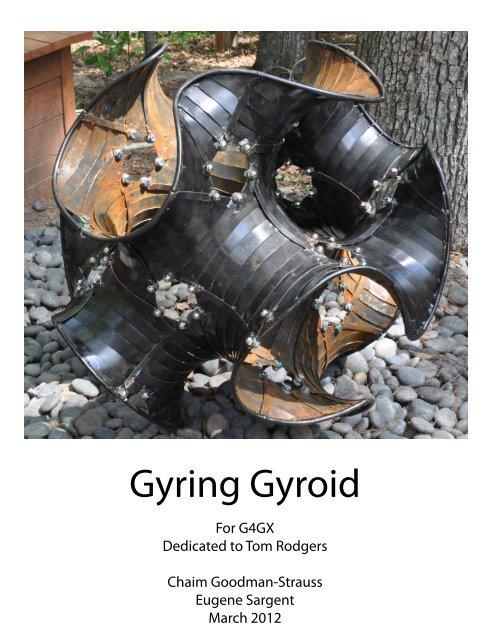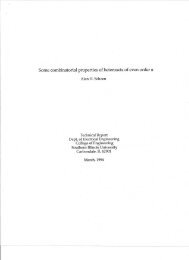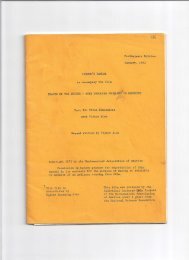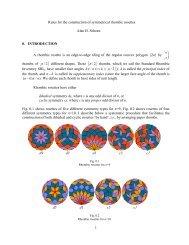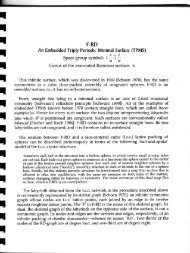Gyring Gyroid - Alan Schoen geometry
Gyring Gyroid - Alan Schoen geometry
Gyring Gyroid - Alan Schoen geometry
- No tags were found...
You also want an ePaper? Increase the reach of your titles
YUMPU automatically turns print PDFs into web optimized ePapers that Google loves.
<strong>Gyring</strong> <strong>Gyroid</strong>For G4GXDedicated to Tom RodgersChaim Goodman-StraussEugene SargentMarch 2012
<strong>Gyring</strong> <strong>Gyroid</strong>The proposed sculpture is a spherical portion of the famous gyroid, a minimal surface found by <strong>Alan</strong><strong>Schoen</strong> in 1970.The piece is to consist of 42 steel units; it is scaled to the <strong>geometry</strong> of its companion piece, DoubleTriamond, w/ Hexastix! As usual, it will be completely hand-crafted and assembled on site.The remarkable gyroid is a periodic minimalsurface, discovered by <strong>Alan</strong> <strong>Schoen</strong>.Minimal surfaces are precisely those that areperfectly balanced under tension—soap films, forexample, necessarily form minimal surfaces.Another way to state this is that minimal surfacesare locally area minimizing; for this reason theyoften appear, for example, at the boundary of twonon-mixing fluids, in living systems and in certaincrystallographic structures. The gyroid, forexample, appears in nature in certain zeolites andin the chitinous structures creating iridescence insome butterfly wings.These soap films are the precise shape of the unitwe will use in the sculpture, showing how they fittogether to form the gyroid.
We use a technique of building surfaces of negativecurvature, from strips of flat material:The celebrated Gauss-Bonet Theorem demonstrates thatthe total curvature of a disk-like region of a surface (forexample, one of our units) is precisely captured bymeasuring the turning excess or deficit around itsboundary. For example, consider this decagon with ten120° angles; as we go around its boundary, we turn 60°ten times, for a total of 600° — an excess of 240° over thecustomary 360° for flat surfaces. This excess is a precisemeasurement of the total negative curvature across thedecagon.We can control this with exquisite precision. Hereis a recent sculpture of a constant negativecurvature surface made from pentagons andsquares; the angles at the corners are worked outprecisely so that the total curvature per unit ofarea (i.e. the Gaussian curvature) is the sameacross the entire surface.The gyroid, like all minimal surfaces (other thanthe plane) is not a constant curvature;nonetheless, this technique gives precise control,and we use this technique to control the surfaceof the piece very finely.
Throughout, we relied on physical models for gaining intuition. Below are papermodels of the mu-snub cube which has the same topology as the gyroid surface,a smooth version of the mu-snub cube and paper versions of our unit, assembledinto a version of the sculpture.
The symmetry of the gyroid is the top quarter space group, 8 0 /4 in the Conway notation. As such, like theDouble Triamond w/ Hexastix! it is remarkably hard to “see”, even when looking directly at a model of it!Amusingly, the gyroid is closely approximated by the solution to cos x sin y + cos y sin z + cos z sinx = 0 ,which gives a quick way to make images such as these. Our clipping sphere is of radius 5/4 π.
The gyroid and the triamond are closely related, as shown here; the sculptures Double Triamondand <strong>Gyring</strong> <strong>Gyroid</strong> are scaled to the same unit, and at least in principle could be intertwined. (Thehexastix in the former precisely would go through the hexagonal holes in the latter.In this scale, the clipping sphere works out to be 42” in diameter.
The gyroid is approximated by Conway’s mu-snub cube, a polyhedron consisting of a hexagon, a squareand three triangles at each vertex. This gives, on the one hand, a map from the 642 symmetry of thehyperbolic plane, and on the other, a natural tiling of the surface of the gyroid. We exploit this in thesculpture: our basic unit is one of these squares, with its neighboring triangles attached; the hexagons areleft as holes.In the figures above, we see an early stage of our modeling process, as the mucube is “evolved” in KenBrakke’s Surface Evolver, steadily tightening its surface until it reaches a close approximation of the gyroid.Here, for comparison, is the same tiling in thehyperbolic plane, which is wrapped up ontothe gyroid at right above.
Our modeling process required finding appropriate modules for the sculpture. Wemodify our tiling of the surface to emphasize the squares and minimize the hexagons.By eye we choose one of the geodesic pathsradiating out of a two-fold center; this pathbecomes the edge of our unit.At last, after weeks of modeling, we were able to see thestructure of the <strong>Gyring</strong> <strong>Gyroid</strong> sculpture for the first time!
To better understand the particular way the modules would be assembled, Sargent wrote aspecial purpose program for manipulating a model of the sculpture.
And we move out of the computerand into the shop!From the computer data, we first built a jig, shown at left above, that positioned points on the surface.This was filled in with clay, then rubber and plaster molds were made.From these, our first copies of the module were made, in fiberglass. On these, we drew the <strong>geometry</strong>of we would use for the strips, working by eye, seeking pleasing curves. Additional experimentationled to a method of shaping strips for the surface of the unit.
Early test assemblies.
The spherical clipping of the surface was sketched out directly on the untrimmed units,using a spherical compass—a wire anchored at the center of the sculpture
We invited friends overto Chaim’s house for aSunday afternoon test assembly.Eugene wandered off for most ofit, to see how well it went togetherin other people’s hands.
We applied the final patina in front of our first piece, Double Triamond, w/ Hexastix! (2008)
The final assembly at the party on March 31, 2012, at Tom and Sarah Rodgers’ house in Atlanta.
Our sincere thanks to Tom and Sarah Rodgers,and the Gathering For Gardner for thiswonderful opportunity.


